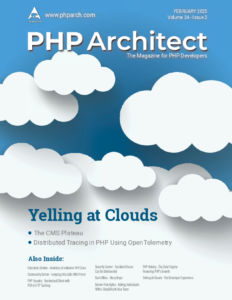Posts marked with “data”
finally{}: Fun with Big Data
In years past, scientists had to draw conclusions from whatever small data they could procure themselves. Advancements in data collection, storage, and analysis have revolutionized the data sets now available to scientists—and also you and me.
CQRS And Event Sourcing—Software Architecture at a Higher Level, for Everyone!
Implementing CQRS and Event Sourcing in your application may allow you to improve performance, user response time and make fixing bugs a more painless process. Although they are not new topics, they are useful when you need to split responsibility or track what’s happening with your data, not only your code. Let’s understand better how […]
PHP Puzzles: Improved Directions
In our last issue, we simulated population growth—a component of many popular games. In this article, we look at pruning redundant items from a list of directions.
Education Station: Data Structures, Part Two
Last month I talked about how, despite PHP arrays being one of the nicest things about the language, there were times where real data structures could help. There were various ways to use arrays as more “traditional” data structures, as well as the options provided by the Standard PHP Library, or SPL. If you can […]
Map, Filter, and Reduce in PHP
Even though MapReduce was created for parallelization, which PHP does not natively support, the syntax is supported. In this article, I outline how to use map, filter, and reduce with PHP collections and the benefits you can gain over traditional for loops.
Serverless, ReactPHP, and Expanding Frontiers
PHP is no longer limited to sitting behind a web server like Apache or NGINX waiting for requests to process. Serverless PHP with AWS’s lambda service is now possible. At the same time, you can also write event-driven, asynchronous servers with ReactPHP. In this issue, we take a look at these new ways to use PHP.
Internal Apparatus: Memory Abstractions
We normally don’t care about abstractions in software, because they exist to hide details we shouldn’t need to care about. However, sometimes, we do need to know the detail. An essential part of how PHP works involves memory management. This month we’ll see new ways to think of memory itself; we’ll also introduce a learning tool we’ll be using in upcoming articles. We’ll be simulating an ancient mainframe computer, and its hard-wired operator console, using modern text messages.
Education Station: Data Structures, Part One
I’ll admit, one of the best things I love about PHP is that I don’t have to deal with all sorts of different ways to deal with data. At the base of the language we have nice primitives like strings, integers, floats, and Booleans, and we also have one of the most flexible structures known to programmers—the PHP Array. The array itself wears many hats. If you are coming from other languages, you have to think about the structure of ordered data in a few different ways. The reason for this tends to deal mostly with how we need to represent data and how we manipulate data. Different data has different requirements.
More powerful Validation from Respect
Dirty data: nobody likes it. It’s one of the biggest problems any web developer faces, where the input given by a user must validated before it can be accepted. Without this necessary step someone could wreck all sorts of havoc on your application, whether it’s just causes errors to appear or worst case opens security holes to allow malicious activity.










